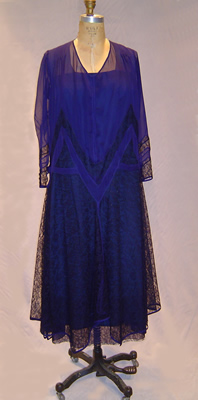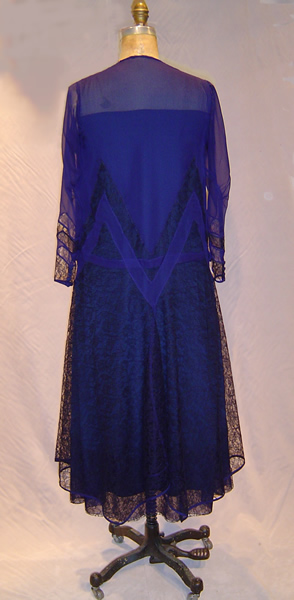Creating the Reproduction
I created the pattern for the reproduction dress by laying out the original dress and tracing it whenever possible, which worked very well on the skirt and bodice. When it was not possible to do this, especially on the sleeves and the tucks on the bodice, I measured the original and plotted the pattern. Since I believe the lining was reworked from something else and was asymmetrical as a result, I draped my lining using the shape of the original as a reference.
| Reproduction Front | Reproduction Back |
 |
 |
I found all of my fabrics at Mood in New York City. The original was made from silk chiffon, silk crepe de Chine, and rayon lace. I was able to find chiffon of the correct weight, but modern crepe de Chine is lighter weight and 3 and 4 ply crepes were too heavy. The best option I found was to use the matte side of silk charmeuse. The lace was the most difficult fabric to find. The modern laces I found were mostly made from polyester or nylon. Most laces were much denser than the soft, open lace on the original. There are very few colored lace options, and synthetic lace would not dye easily to the deep color I needed. Finally, silk lace, the closest thing to the original in texture, was out of my price range at a hundred or more dollars per yard. The lace I found was a good color, though slightly darker than the original, and a good weight and density. It is made from nylon and therefore slightly stiffer than the original, but steaming helped soften it. The lace I bought was only 30” wide, the exact width of my skirt panels. As there is no seaming in the original skirt panels, perhaps this was also the width of the original lace and dictated the width of the panels.
The cutting challenges in this garment were due to the fabrics. The chiffon had to be securely pinned to the table so as not to shift off grain during the cutting process. All of the lace had to be thread marked because tracing was invisible on the lace. To keep the chiffon insets from hanging off grain, I cut them in one with the bodice and thread marked them, only cutting them apart immediately before seaming in the lace.
Sewing was probably my greatest challenge in creating the reproduction. The chiffon wanted to grow on the bias on all of my inset seams. The most difficult part of the construction was setting the chiffon tube at the waist level in the inset. Much of the original dress was basted together by hand then stitched by machine, so essentially I put the dress together twice. Also, much of the interior finishing was done by hand, as was all of the binding on the placket and lace panels. I had little experience hand sewing on chiffon, and this was definitely a lesson is patience. I spent approximately 100 hours cutting and assembling this dress.
I made three very minor changes in the reproduction from the original dress. First, the original crinkle chiffon top and the chiffon panel on the hem of the lining were finished with a picot machine. Not having access to this piece of equipment, I finished these edges by straight stitching, trimming the seam allowance to 1/16”, and then zigzagging over the straight stitch and raw edge to for a picot. Second, I eliminated the irregular pleats on the sides of the lining and replaced them with regular pleats. This is only visible from the interior of the lining. Finally, some of the seam allowances on the inset were unfinished in the original and those that were finished used a variety of different methods including roll hemming the chiffon over the lace and hand overcastting. I finished them all with hand overcastting, which was the most prevalent finishing method in the original.
I enjoyed making this reproduction very much and helping out an organization in my hometown that I’ve been involved with for many years. In 1994 I helped with the restoration of the house, chipping mortar from old bricks as they were taken down to replace the structural walls, so the original bricks could be reused. I’m glad to be able to use my professional skills for the benefit of the place where I grew up and for the enrichment of its people. I am also honored to be a part of conserving the legacy of a woman who gave so much to the women of our country and the world.
© Jennifer Jacob, 2006

